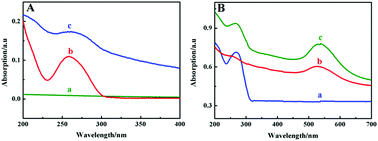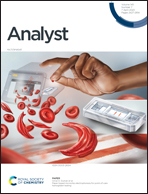A dendritically amplified fluorescent signal probe on SiO2 microspheres for the ultrasensitive detection of mercury ions†
Abstract
In this work, a new kind of dendritically amplified fluorescent signal probe on SiO2 microspheres was controllably fabricated by the terminal deoxynucleotidyl transferase (TdT)-catalyzed incorporation of nucleotides combined with bio-barcode (BBC) amplification for the ultrasensitive detection of Hg2+. A thymine T–Hg2+–T hairpin structure was first formed and further initiated the strand displacement amplification (SDA) reaction, generating a mimic target (MT). MT hybridized with a capture probe 1 (C1) on SiO2 microspheres, and the 3′-hydroxyl (OH) termini of MT initiated TdT-based DNA extension, producing abundant poly-guanine sequences (G1). Then, G1 hybridized with a capture probe 2 (C2) with abundant cytosine (C) species to assemble multiple C2/reporter probe-AuNPs onto the SiO2 microspheres. The reporter DNA further initiated TdT-based extension with a poly-T sequence (T1) to link large numbers of signal probes, which generated a very high fluorescence signal for the ultrasensitive detection of target Hg2+. This TdT-based signal amplification method coupled with SDA exhibits extraordinary sensitivity for Hg2+ assay with a limit down to 1.0 aM. The proposed highly sensitive fluorescence strategy holds great potential for detecting targets in environmental and biological fields.



 Please wait while we load your content...
Please wait while we load your content...